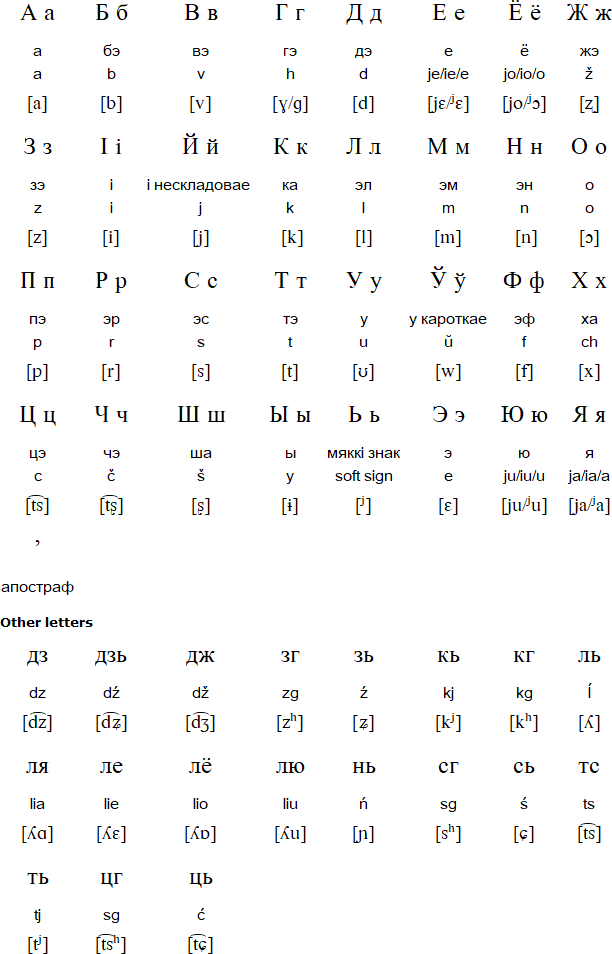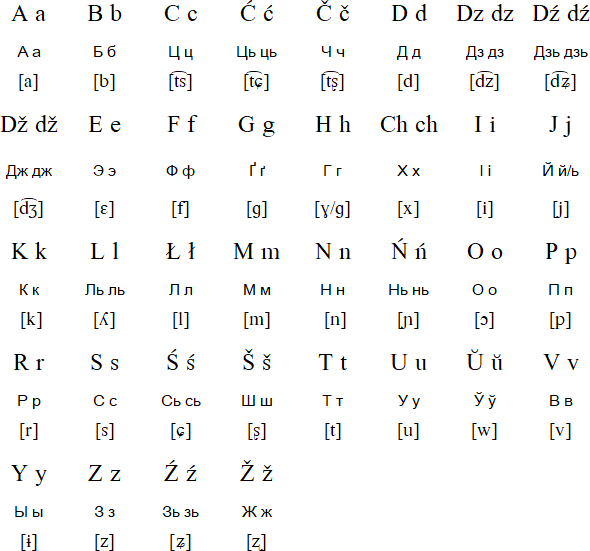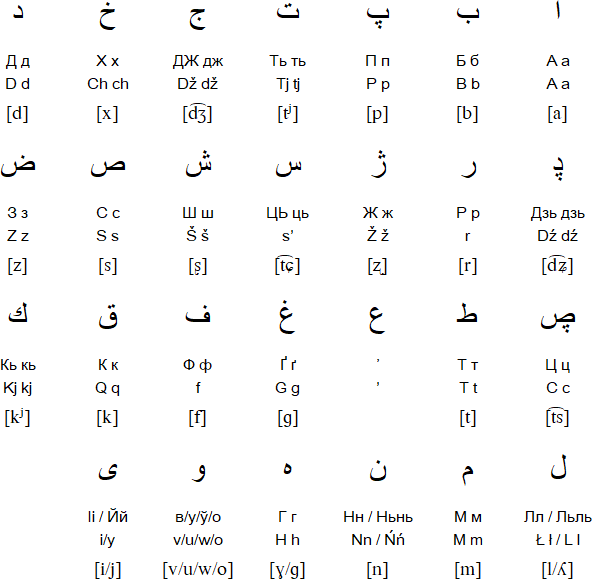Belarusian is an Eastern Slavonic language spoken mainly in Belarus, and also in Poland, the Czech Republic, Ukraine, Lithuania, Russia, Canada, the USA and Israel.
According to a study carried out by the Belarusian government in 2009, 2.8 million (29.4%) out a population of 9.67 million could write, speak and read Belarusian in Belarus, and 5 million (52.5%) could read and speak it. However, only 1.15 million (11.9%) used Belarusian at home.
There were 316,000 Belarusian speakers in Russia based on the 2002 census, 55,000 in Ukraine per the 2001 census, and 40,000 in Poland per the 2002 census.
The Belarusian Wikipedia page shows a population of 6.34 million Belarusian speakers in Belarus, 30,000 in Lithuania and about 10,000 in Canada.
Based on these figures, the total number of speakers is between 6.79 and 8.25 million.
Belarusian is an official language in Belarus and parts of Poland, and is recognised as a minority language in the Czech Republic, Ukraine and Lithuania.
Belarusian is closely related to Russian and Ukrainian, and mutually intelligible with them to some extent.
The country now known as the Belarus was part of the Grand Duchy of Lithuania from the mid 13th century until the end of the 18th century. An archaic form of Belarusian known as "Old Belarusian" was the offical language of the Grand Duchy and and was initially written with the Cyrillic alphabet. Due to the domination of the Greek Orthodox Church in the region, the written form of Belarusian was heavily influenced by Church Slavonic, the liturgical language of the Orthodox church.
During the 16th century a Reformation and Counter-Reformation led to the purging of Church Slavonic elements from literary Belarusian. It was also during this period that handwritten Belarusian texts started to appear in the Latin alphabet (Lacinka). The earliest known printed Belarusian text in the Latin alphabet appeared in Witanie na Pierwszy Wiazd z Krolowca do Kadlubka Saskiego Wilenskiego, a Jesuit anti-Lutheran publication published in Wilno in 1642.
The Russian invasion of 1654-1667 caused to the destruction of many Belarusian cities and the deaths of about half the population, including 80% of the urban population. By 1710, Old Belarusian was replaced by Polish as the official language of the region, however Belarusian continued to appear in writing in a limited way.
During the late 19th century, Belarusian, written in the Latin alphabet, started to emerge as a literary language closer to its modern form. It took many years for people to agree on a standard spelling system: some favoured Polish-based systems, some prefered Russian-based systems, and others used systems based on the Belarusian version of the Latin alphabet. Eventually a compromise was reached which combines elements from all these systems. It was during this time that Belarusian started to be written with the Cyrillic alphabet as well.
During the early 20th century, many Belarusian publications were printed in both the Latin and Cyrillic alphabets. After the Soviet invasion of eastern Belarus in 1919-1920, the Cyrillic alphabet became the only alphabet used in official writings. Meanwhile in western Belarus, the Latin and Cyrillic alphabets continued to coexist, though after 1943 the majority of publications were printed in the Cyrillic alphabet. One notable exception was publications written by Belarusian emigrés, who favoured the Latin alphabet.
Since Belarus gained independence in 1991, efforts have been made to revive Belarus writing in the Latin alphabet. One major problem is that nobody can agree on a spelling system.
Belarusian has also been written with the Arabic script by Belarusian Tartars and with the Hebrew script by Belarusian Jews.

Hear the Belarusian alphabet:


Download alphabet charts for Belarusian (Excel)
Corrections and additions by Michael Peter Füstumum, Robert Hodge and Tory Palmieri
Усе людзі нараджаюцца свабоднымі і роўнымі ў сваёй годнасці і правах. Яны надзелены розумам і сумленнем і павінны ставіцца адзін да аднаго ў духу брацтва.
Usie ludzi naradžajucca svabodnymi i roŭnymi ŭ svajoj hodnaści i pravach. Jany nadzieleny rozumam i sumleńniem i pavinny stavicca adzin da adnaho ŭ duchu bractva.
Hear a recording of this text by Yuri from Belarus
All human beings are born free and equal in dignity and rights. They are endowed with reason and conscience and should act towards one another in a spirit of brotherhood.
(Article 1 of the Universal Declaration of Human Rights)
Information about Belarusian | Phrases | Numbers | Tower of Babel
Belarusian language resources on Amazon
Learn Belarusian with Glossika
Information about the Belarusian language
http://en.wikipedia.org/wiki/Belarusian_language
https://be.wikipedia.org/wiki/Беларуская_мова
https://en.wikipedia.org/wiki/Belarusian_Arabic_alphabet
http://www.belarus-misc.org/bel-ling.htm
http://www.pravapis.org
Details of the Latin alphabet for Belarusian, and Belarusian texts in the Latin alphabet
http://www.cus.cam.ac.uk/~np214/lacin.htm
https://lacinka.teksty.seveleu.com/
Online Belarusian lessons
http://www.radiobelarus.tvr.by/en/content/belarusian-language-lessons
http://mylanguages.org/learn_belarusian.php
http://en.wikibooks.org/wiki/Belarusian
http://polymath.org/belarusian.php
Belarusian phrases
http://www.pravapis.org/art_phrases1.asp
http://www.bbc.co.uk/languages/other/quickfix/belarusian.shtml
http://www.belarusguide.com/dictionaries/engblr/special.html
Belarusian dictionaries
https://www.bielmova.org
http://www.slounik.org/
https://www.skarnik.by/tsbm
http://www.belarusguide.com/dictionaries/engblr/index.html
Belarusian learning software
http://www.linguashop.com/belarusian-courses
Online resources for learning Belarusian (in Russian)
http://padrucnik.by.ru/spasylki/padrucniki_ru.htm
Belarusian transliteration and spell check
http://by.translit.cc/
http://www.translitteration.com/transliteration/en/belarusian/national/
Online Belarusian radio
http://www.svaboda.org
http://www.intervalsignals.net/countries/belarus.htm
Online Belarusian news
http://nn.by
http://carkva-gazeta.by
http://www.gazeta.bsu.by
http://www.belarus.net/minsk_ev/index_b.htm
Free Cyrillic fonts
http://www.wazu.jp/gallery/Fonts_CyrS.html
http://www.fingertipsoft.com/ref/cyrillic/fontlist.html
http://www.typography.com/collections/cyrillic/
http://kodeks.uni-bamberg.de/AKSL/Schrift/RomanCyrillicStd.htm
Belarusian, Bosnian, Bulgarian, Croatian, Czech, Goral, Kashubian, Knaanic, Macedonian, Montenegrin, Old Church Slavonic, Polish, Russian, Rusyn, Serbian, Silesian, Slovak, Slovenian, Sorbian, Ukrainian, West Polesian
Adamaua Fulfulde, Afrikaans, Arabic (Algerian), Arabic (Bedawi), Arabic (Chadian), Arabic (Egyptian), Arabic (Gulf), Arabic (Hassaniya), Arabic (Hejazi), Arabic (Lebanese), Arabic (Libyan), Arabic (Modern Standard), Arabic (Moroccan), Arabic (Najdi), Arabic (Sudanese), Arabic (Syrian), Arabic (Tunisian), Arwi, Äynu, Azeri, Balanta-Ganja, Balti, Baluchi, Beja, Belarusian, Bosnian, Brahui, Chagatai, Chechen, Chittagonian, Comorian, Crimean Tatar, Dargwa, Dari, Dhatki, Dogri, Domari, Gawar Bati, Gawri, Gilaki, Hausa, Hazaragi, Hindko, Indus Kohistani, Kabyle, Kalkoti, Karakalpak, Kashmiri, Kazakh, Khowar, Khorasani Turkic, Khwarezmian, Konkani, Kumzari, Kurdish, Kyrgyz, Lezgi, Lop, Luri, Maba, Maguindanao, Malay, Malay (Terengganu), Mandinka, Marwari, Mazandarani, Mogholi, Morisco, Mozarabic, Munji, Noakhailla, Nubi, Ormuri, Palula, Parkari Koli, Pashto, Persian/Farsi, Punjabi, Qashqai, Rajasthani, Rohingya, Salar, Saraiki, Sawi, Serer, Shabaki, Shina, Shughni, Sindhi, Somali, Soninke, Tatar, Tausūg, Tawallammat Tamajaq, Tayart Tamajeq, Ternate, Torwali, Turkish, Urdu, Uyghur, Uzbek, Wakhi, Wanetsi, Wolof, Xiao'erjing, Yidgha
Abaza, Abkhaz, Adyghe, Aghul, Akhvakh, Akkala Sámi, Aleut, Altay, Alyutor, Andi, Archi, Assyrian / Neo-Assyrian, Avar, Azeri, Bagvalal, Balkar, Bashkir, Belarusian, Bezhta, Bosnian, Botlikh, Budukh, Bulgarian, Buryat, Chamalal, Chechen, Chelkan, Chukchi, Chulym, Chuvash, Crimean Tatar, Dargwa, Daur, Dolgan, Dungan, Enets, Erzya, Even, Evenki, Gagauz, Godoberi, Hinukh, Hunzib, Ingush, Interslavic, Itelmen, Juhuri, Kabardian, Kaitag, Kalderash Romani, Kalmyk, Karaim, Karakalpak, Karata, Karelian, Kazakh, Ket, Khakas, Khanty, Khinalug, Khorasani Turkic, Khwarshi, Kildin Sámi, Kili, Komi, Koryak, Krymchak, Kryts, Kubachi, Kumandy, Kumyk, Kurdish, Kyrgyz, Lak, Lezgi, Lingua Franca Nova, Lithuanian, Ludic, Macedonian, Mansi, Mari, Moksha, Moldovan, Mongolian, Montenegrin, Nanai, Negidal, Nenets, Nganasan, Nivkh, Nogai, Old Church Slavonic, Oroch, Orok, Ossetian, Pontic Greek, Romanian, Rushani, Russian, Rusyn, Rutul, Selkup, Serbian, Shor, Shughni, Siberian Tatar, Sirenik, Slovio, Soyot, Tabassaran, Tajik, Talysh, Tat, Tatar, Teleut, Ter Sámi, Tindi, Tofa, Tsakhur, Tsez, Turkmen, Tuvan, Ubykh, Udege, Udi, Udmurt, Ukrainian, Ulch, Urum, Uyghur, Uzbek, Veps, Votic, Wakhi, West Polesian, Xibe, Yaghnobi, Yakut, Yazghulami, Yukaghir (Northern / Tundra), Yukaghir (Southern / Kolyma), Yupik (Central Siberian)
Languages written with the Latin alphabet
Page last modified: 10.10.22
[top]
You can support this site by Buying Me A Coffee, and if you like what you see on this page, you can use the buttons below to share it with people you know.

If you like this site and find it useful, you can support it by making a donation via PayPal or Patreon, or by contributing in other ways. Omniglot is how I make my living.
Note: all links on this site to Amazon.com, Amazon.co.uk
and Amazon.fr
are affiliate links. This means I earn a commission if you click on any of them and buy something. So by clicking on these links you can help to support this site.
[top]